Rancang Bangun Pengering Ikan Teri Tenaga Surya dengan Kolektor Pelat Datar dan Turbin Ventilator
DOI:
https://doi.org/10.25181/tektan.v7i3.829Abstract
The fish will quickly be damaged when the post-harvest handling is not done the right way. One of the pickling process is inexpensive and commonly performed by drying. One dried fish that is often consumed by people is anchovy. The manufacturing process anchovy done traditionally by means of direct drying in the sun on a patch of para-para. The drying process is often hampered by the way the weather factor, making it less efficient because it takes a long time, require a comprehensive and drying results prone to contamination dirt and other contamination. Utilization of solar energy that is abundant in Indonesia can be used as a dryer to reduce the use of fossil-based energy. This research aims to create and test performance anchovy dryer design and build solar energy. The working principle of the dryer is made of heat radiation collected by the solar flat plate collectors are arranged such that it can be used to heat the air flowing in the hallway under the flat plate collectors with dimensions of 4 m width, length and height of 7.5 m 0.5 m. In order for heating the air inside the hall optimum, then the inhibition of air flow by installing a bulkhead inside the hall are arranged in winding. The resulting hot air is used to dry the product that is placed in the drying chamber. The airflow from the inlet to the outlet in the system is due to the movement of the turbine ventilator by the flow of air / wind around the dryer. Performance test results anchovy solar dryer is 50-60OC drying air temperature, RH 12-40% in the drying chamber, the drying capacity of 12.5 kg/hour. Keywords: solar dryers, flat plate collectors, anchovy, turbine ventilatorDownloads
References
Abdullah, Kamaruddin,2003, “Fish Drying Using Solar Energy†Lectures and Workshop Exercises on Drying of Agricultural and Marine Products: Regional Workshops on Drying Technology, Jakarta, 159-191.
Brooker, D.B., Bakker-Arkema, F.W., Hall, C.W. 1992. Drying and Storage of Grains and Oilsedds. Van Nostrand Reinhold, New York.
Ekechukwu, O.V., Norton, B., 1999, “Review of Solar-Energy Drying Systems II: an Overview of Solar Drying Technologyâ€, International Journal of Energy Conversion & Management, Vol. 40(1), 615-655.
Fudholi, A., M. Y. Othman, M. H. Ruslan, M. Yahya, A. Zaharim and K. Sopian, “Theeffects of drying air temperature andhumidity on drying kinetics of seaweedâ€, in Recent Research in Geography, Geology,Energy, Environment and Biomedicine, Corfu, 2011, pp. 129-133.
Fudholi, A., M. H. Ruslan, L.C. Haw, S. Mat, M. Y. Othman, A. Zaharim and K. Sopian, “Mathematical modeling of Brown SeaweedDrying Curvesâ€, in in WSEAS Int. Conf. onApplied Mathematics in Electrical andComputer Engineering, USA, 2012, pp. 207-211.
Fudholi, A., M. Y. Othman, M. H. Ruslan, M. Yahya, A. Zaharim and K. Sopian, “Design and testing of solar dryer for drying kinetics of seaweed in Malaysia,†in Recent Researchin Geography, Geology, Energy,Environment and Biomedicine, Corfu, 2011, pp. 119-124.
Gorjian, S., T. Tavakkoli Hashjin, M.H. Khoshtaghaza and A.M. Nikbakht. 2011. Drying Kinetics and Quality of Barberry in a Thin Layer Dryer. J. Agr. Sci. Tech. 13 : 303-314.
Henderson, S.M., and Perry, R.L. 1976. Agricultural Process Engineering. Wiley, New York.
Heruwati, E.S., 2002, “Pengolahan Ikan secara Tradisional : Prospek dan Peluang Pengembangan, Pusat Riset Pengolahan Produk dan Sosial Ekonomi Kelautan dan Perikananâ€, Jurnal Litbang Pertanian, Vol.21(3), 92-99.
Kituu, G.M., D. Shitanda, C.L. Kanali, J.T. Mailutha, C.K. Njoroge, J.K. Wainaina, V.K. Silayo. 2010. Thin layer drying model for simulating the drying of Tilapia fish (Oreochromis niliticus) in a solar tunnel dryer. Journal of Food Engineering 98: 325-331.



